

Zitierweise / cite as:
Carakasaṃhitā: Ausgewählte Texte aus der Carakasaṃhitā / übersetzt und erläutert von Alois Payer <1944 - >. -- Anhang B: Tierbeschreibungen. -- Antilopinae. -- Fassung vom 2007-09-11. -- URL: http://www.payer.de/ayurveda/tiere/antilopinae.htm
Erstmals publiziert:
Überarbeitungen:
Anlass: Lehrveranstaltung SS 2007
©opyright: Dieser Text steht der Allgemeinheit zur Verfügung. Eine Verwertung in Publikationen, die über übliche Zitate hinausgeht, bedarf der ausdrücklichen Genehmigung des Verfassers
Dieser Text ist Teil der Abteilung Sanskrit von Tüpfli's Global Village Library
WARNUNG: dies ist der Versuch einer
Übersetzung und Interpretation eines altindischen Textes. Es ist keine
medizinische Anleitung. Vor dem Gebrauch aller hier genannten Heilmittel wird
darum ausdrücklich gewarnt. Nur ein erfahrener, gut ausgebildeter ayurvedischer
Arzt kann Verschreibungen und Behandlungen machen!
Falls Sie die diakritischen Zeichen nicht dargestellt bekommen, installieren Sie eine Schrift mit Diakritika wie z.B. Tahoma.
Verwendete und zitierte Werke siehe: http://www.payer.de/ayurveda/caraka000b.htm
siehe auch:
In Indien kommen außer den weiter oben bzw. unten genannten u.a. folgende Antilopen- und Gazellenarten vor:
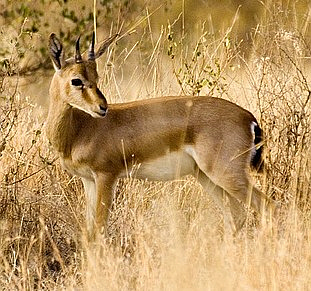
Abb.:
Gazella bennettii - Chinkara - Indische Gazelle, Gir Forest
National Park, Gujarat (ગુજરાત)
[Bildquelle: Wikipedia]
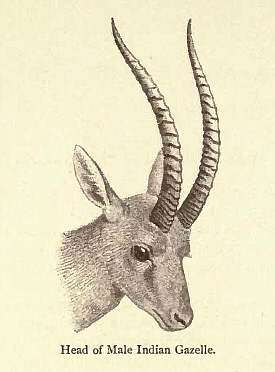
Abb.: Kopf und Geweih von
Gazella bennettii, Bock
[Bildquelle: Ward, 1903]
Lydekker:
"The Indian gazelle (G. bennetti), brings us to a subgroup distinguished from the preceding by the horns not being distinctly lyrate, but generally having a slight S-shaped curvature when seen from the side.
The general colour of this well-known species the ravine-deer of Indian sports
men is light chestnut above, while the tail is blackish.In height the buck stands 26 inches at the withers ; and the horns, which usually have fifteen or sixteen rings, average 10 to 12 inches in length along the curve.
This species inhabits the plains of Central and North-Western India, whence it extends through Baluchistan to Persia.
It is commonly found in parties of from two to six, although occasionally from ten to twenty
may be found together. Its swiftness is such that it can but seldom be taken with dogs ; but it does not leap in the air like the dorcas. Mr. Blanford writes that this gazelle "keeps much to waste ground, especially where that is broken up by ravines, but it is seldom seen on alluvial plains, and it haunts cultivation less than the [Indian] antelope. It is frequently found amongst scattered bushes or thin tree-jungle, and may be met with on undulating ground even on the top of hills ; it is commonly found amongst sand-hills, and is nowhere so abundant as in parts of the Indian desert. It lives on grass and the leaves of bushes, and I believe never drinks, for it is common in tracts where there is no water except from deep wells.""[Quelle: Lydekker, Richard <1849-1915>: The royal natural history / edited by Richard Lydekker ; with preface by P.L. Sclate. -- London ; New York : F. Warne, 1893-96. -- 6 Bde. : ill. (some col.) ; 26 cm. -- Bd. 2. -- S. 292f. -- Online: http://www.archive.org/details/royalnaturalhist02lyderich. -- Zugriff am 2007-09-27]
Blanford:
"Genus GAZELLA, Blainville (1816).
Syn. Procapra, Hodgs. (1846) : Tragops, Hodgs. (1847) ; Tragomma, Hodgs. (1848).
Size small or moderate. Frame slender. Eyes large. Tail short. Suborbital glands small, sometimes wanting. Interdigital glands in all feet. Inguinal glands generally present. No muffle. Mammae 2. Hoofs pointed. Generally a tuft of longer hair on each knee.
Fig. 171. Skull and horns of Gazella bennetti.Skull resembling that of Antilope, but shorter in proportion. Nasals short. Lachrymal fossa variable: a distinct lachrymal fissure. Auditory bullae large. Horns sometimes in both sexes, those of the male compressed, oval in section, erect, with a more or less marked siginoid curve, sublyrate or lyrate, surrounded by subdistant prominent rings almost throughout.
This genus contains more than 20 species, distributed throughout Africa, Western and Central Asia (Brooke, P. Z. S. 1873, p. 535). Remains belonging to it are found in Indian Pleistocene and Pliocene deposits, those in the former agreeing with G. bennetti.
Synopsis of Indian Species.
Females horned. Horns not turning inwards at points ; no caudal disk G. bennetti, p. 526.
Females hornless.
No caudal disk. Horns lyrate ; the tips turned inwards G. subgutturosa, p. 528.
A white disk surrounding the tail. Horns much curved G. picticaudata, p. 529.
Gazella bennetti. The Indian Gazelle.
Antilope bennettii, Sykes, P. Z. S. 1831, p. 104 ; Stanford, J. A. S. B. xxxvi, pt. 2, p. 196.
Antilope arabica, Elliot, Mad. Jour. L. S. x, p. 223 (1839), nec Licht.
Gazella christii, Gray, apud Blyth J. A. S. S. xi, p. 452 (1842) ; Hutton, J. A. S. B. xv, p. 151.
Gazella bennetti, Gray, List Mam. B. M. 1843, p. 161 ; Button, J. A. S. B. xv, p. 150 ; Jerdon, Mam. p. 280 ; Stoliczka, J. A. S. K. xli, p. 229 ; Blanford, P. Z. S. 1873, p. 315 ; Brooke, P. Z. S. 1873, p. 544 ; Ball, P. A. S. B. 1877, p. 172 ; W. Sclater, Cat. p. 159.
Antilope hazenna, Is. Geoffr. Jacquemont, Voyage, iv, Zool. p. 74. Atlas, ii, pi. vi (1844).
Tragops bennetti, Hodgson, J. A. S. B. xvi, p. 695 ; Adams, P. Z. S. 1858, p. 622 ; Blyth, Cat. p. 173.
Gazella fuscifrons, Blanford, P. Z. 8. 1873, p. 317; id. Eastern Persia, ii, p. 92 ; Brooke, P. Z. S. 1873, p. 545.
Chinkāra, Chikāra, Sal-punch, H. ; Phaskela, N.W. P. ; Ask or Ast, Ahu, Baluch ; Khazm, Brahui ; Kalsipi, Mahr. ; Tiska, Budāri, Mudari, Can. ; Sank-hule, Mysore ; Porsya (male) , Chari (fem.), Baori ; Burudu-jinka, Tel. ; Ravine deer of some Anglo-Indians.
Horns present in both sexes, those in the male nearly straight, diverging slightly from the base when viewed from the front, but having a slight S-shaped curve when seen from the side, the points curving a little forward ; the number of rings is generally 15 or 16, but is said to be sometimes as many as 25 ; the horns in the female are much smaller, smooth and conical. Infraorbital gland distinct, having a small opening.
Colour above light chestnut, a little darker where it joins the white on the sides and buttocks ; no pale lateral band's ; chin, breast, lower parts, and back of thighs white, the white colour not ascending to the root of the tail ; tail nearly black, knee-brushes varying, often dark brown ; a whitish streak down each side of the face ; middle of face from base of horns to nostrils darker rufous, sometimes with a dusky patch above the nose ; a rufous stripe outside each pale facial band.
Dimensions. An adult male measured 26 inches high at the shoulder, 28.5 at the croup, nose to rump 41.5, tail 8.5, ear 6, horns 11 (Elliot). Weight of bucks about 50 lb., of does 35 to 40. Basal length of a male skull 6.75, orbital breadth 3.6. Horns measured in front along the curve are usually 10 to 12 inches long, with a girth of 4 at the base ; the largest recorded dimensions in males are 14 and 5, the longest known female horns measure 8 inches.
Distribution. Throughout the plains and low hills of Northwestern and Central India, extending throughout Baluchistan to the eastern shore of the Persian Gulf. This gazelle is found in a considerable part of the Peninsula, ranging in suitable localities throughout the Punjab., Sind, Rajputana, the N.W. Provinces, and the whole Bombay Presidency with the exception of the Western Ghats and Konkan ; also Central India as far east as Palamow and Western Sarguja, and the Central Provinces as far east as Seoni and Chanda, together with the Hyderabad territories, and the Madras Presidency to a little south of the Kistna, gazelles being found at Anantapur, south of Kurnool, and in Northern Mysore.
Varieties. G. fuscifrons was described from a doe with distinctly, though not prominently ringed horns, 7.25 inches long, and with the dark portions of the face dark brown, obtained at Jalk in Northern Baluchistan. Sir O. B. St. John, after long search, obtained what he justly concluded must be the male, and this proved to be G. bennetti. The rather pale form of this gazelle from the Indian desert and Sind has been distinguished as Gazella christii, but is perfectly identical with the Central Indian type.
Habits. The Indian gazelle is far less gregarious than the Indian antelope, and is most commonly seen in small parties of from two to six, though I have found from ten to twenty associating in a herd. It keeps much to waste ground, especially where that is broken up by ravines, but it is seldom seen on alluvial plains, and it haunts cultivation less than the antelope. It is frequently found amongst scattered bushes or thin tree-jungle, and may be met with on undulating ground even on the top of hills ; it is commonly found amongst sand-hills, and is nowhere so abundant as in parts of the Indian desert. It lives on grass and the leaves of bushes, and I believe never drinks, for it is common in tracts where there is no water except from deep wells ; and although I was on the look out for some years, and saw the tracks of almost every common wild animal at the pools in stream-beds, the only water remaining in many places in the hot season, I never saw the easily recognized prints of the gazelle's hoofs. It is, however, fond of the green grass near water.
Gazelles are very swift and can but rarely be caught by dogs.
The present species does not bound like the Indian antelope when disturbed. It has a peculiar habit of uttering a sharp hiss when alarmed and of stamping with its fore-foot. The doe is often seen followed by two fawns. I cannot find that the rutting-season or the period of gestation has been observed. The flesh is excellent.
This species has the habit of dropping its dung repeatedly in the same spot to a greater extent than the Indian antelope, but it not unfrequently resorts to heaps of nilgai dung for the sake of depositing its own.
Gazella dorcas and several allied forms found in Northern and Eastern Africa, G. arabica and G. muscatensis from South Arabia, are nearly allied to G. bennetti."
[Quelle: Blanford, W. T. <1832 – 1905>: Mammalia. -- 1888 - 1891. -- (Fauna of British India including Ceylon and Burma). -- S. 525 - 528. -- Online: http://www.archive.org/details/mammalia00blaniala. -- Zugriff am 2007-09-06]
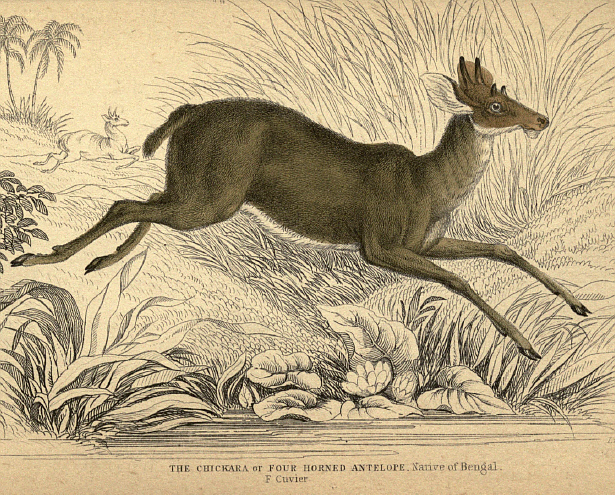
Abb.:
Tetracerus quadricornis - Four-horned Antelope / Chausingha
- Vierhornantilope
[Bildquelle: The naturalist's library. -- Vol. 21. -- 1834ff.]
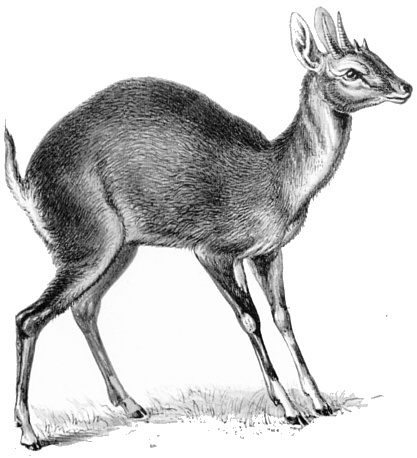
Abb.:
Tetracerus quadricornis - Four-horned Antelope / Chausingha
- Vierhornantilope
[Bildquelle. Wikipedia]
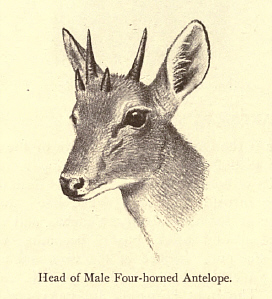
Abb.: Hörner von
Tetracerus quadricornis, Bock
[Bildquelle: Ward, 1903]
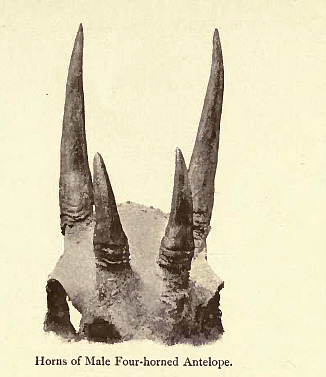
Abb.: Hörner von
Tetracerus quadricornis
[Bildquelle: Ward, 1903]
Blanford:
|
"Genus TETRACERUS, Leach (1825). Size small. A muffle present. An elongate suborbital gland ; interdigital glands confined to the hind feet. No inguinal glands. Hoofs small, rounded in front. Tail short. Mammae 4. Frontal and parietal profile of skull slightly and gently rounded, the occipital meeting the parietal at a right angle. Lachrymal fossa large. Horns in the male only, usually 4 in number in adults ; all the horns short, conical, smooth, the posterior pair much longer than the anterior, which are situated between the orbits, are often mere knobs and are not unfreqnentiy wanting. Jerdon's statement that there are canines in the males is a mistake. There is a single species peculiar to India. This is the only Indian representative of the Cephalophine antelopes of Africa or Duikerboks. Remains of T. quadricornis are found fossil in the Pleistocene cave-deposits of Kurnool, and a small Siwalik ruminant is referred to this genus. Tetracerns quadricornis. The four-homed Antelope. Antilope (Cervicapra)
quadricornis, BlainiiUe, Hull. Soc. Philom. 1816, p. 78. Chousingha, Chouka, Doda, H.; Benkra, Mahr.; Bhokra, Phokra,Guzr., Bhirki, at Saugor ; Bhir, Gond ; Bhirul, Bheel : Kotari, Chutia Nagpur ; Kurus, Gonds of Bastar ; Konda-gori, Tel, ; Kondguri, Kaulla-kuri, Can. ; commonly in the Deccan Jangli bakri. Fur thin, harsh, and short. Tail above with longer hair than on the body. Colour dull pale brown, with a more or less rufous tinge above, passing gradually on the sides and limbs into the white of the lower parts. A dark stripe down the front of each leg, broadest on the fore limbs ; muzzle and ears outside also dark. A dark stripe down the back in some specimens, probably young. Dimensions. Height of a male at shoulder 25½ inches, at croup 27 ; length from muzzle to rump 42, tail (? without hair) 5, ear 4½. Weight 43 lb. Females are rather smaller. Basal length of a large male skull 6.5, orbital breadth 3.2. The posterior horns are usually 3 to 4 inches long, the anterior 1 to 1½ ; maximum recorded lengths 4.5 and 2.5. Distribution. Along the base of the Himalayas from the Punjab to Nepal, and probably in most parts of the Peninsula where the country is wooded and hilly, but not in dense jungle. The fourhorned antelope is not found in the Gangetic plain nor on the Malabar coast in the Madras Presidency. It is said by Mr. Murray to be found in Sind ; it is common in the wooded parts of Rajputana, throughout the Bombay Presidency, the Central Provinces, and the northern parts of Madras, less abundant to the eastward in Chhattisgarh, Chutia Nagpur, Bengal, and Orissa, and to the southward in Mysore, but it occurs in the latter State occasionally, and has been observed on the Nilgiri and Palni hills. It is unknown in Ceylon and east of the Bay of Bengal. In jungle this species and hog-deer (Cervus pordnus) may easily be mistaken the one for the other, and some recorded localities of the latter may be due to this circumstance. Varieties. In the Madras Presidency the anterior horns are said to be but rarely developed, and certainly fully adult animals occur without any, and with only small projections on the skull. But I can see no other difference ; the skulls, whether the anterior horns are developed or not, are precisely similar in form and scarcely differ in size. In the case of a male that I obtained young in Nimar and that was kept alive by a friend in Bombay, the anterior horns did not appear till the third year, although the posterior horns were well developed early in the second. Doubtless many of the two-horned individuals seen are young. Blyth (J. A. S. B. xvii, p. 560) came to the conclusion that the twohorned form is merely a variety ; and after reading all that has been written by McMaster and Sterndale on the subject, I agree with him. Habits. This species differs from all other Indian antelopes in habits as much as in structure. It is not gregarious, very rarely are more than two seen together ; it haunts thin forest and bush, and keeps chiefly to undulating or hilly ground. It drinks daily, and is never seen far from water. It is a shy animal, and moves with a peculiar jerky action, whether walking or running. The rutting-season is in the rains, and the young, one or two in number, are born about January or February, the period of gestation being, according to Hodgson, six months. The placentation has been described by Mr. Weldon (P. Z. S. 1884, p. 2). The present species, according to Elliot, has the habit of depositing its dung repeatedly in one spot. This does not agree with my experience. The name Chinkara has been applied to this animal in error. The flesh is said to be dry, but I have often eaten it and found it better than that of most Indian deer, though not equal to antelope or gazelle. When taken young this antelope is easily tamed" [Quelle: Blanford, W. T. <1832 – 1905>: Mammalia. -- 1888 - 1891. -- (Fauna of British India including Ceylon and Burma). -- S. 519 - 521. -- Online: http://www.archive.org/details/mammalia00blaniala. -- Zugriff am 2007-09-06] |
Gattung Pantholops
Hodgson, 1834
dt. Tschiru, Orongo, Tibetantilope
engl. Chiru, Tibetan Antelope
Vorkommen: Kaschmir (कश्मीर), Tibet und angrenzende Gebiete Nordzentralchinas
Grzimek: Bd. 13, 448f.
Walker: Bd. 2, 1205f.
Wikipedia: http://de.wikipedia.org/wiki/Tschiru. -- Zugriff am 2007-07-20
Abb.: Kopf und Geweih von Pantholops hodgsoni
[Bildquelle: Ward, 1903]
Blanford:
"Genus PANTHOLOPS, Hodgson (1834).
Tail short. No suborbital glands. Large interdigital glands in all feet. Inguinal glands very large. No muffle. The muzzle peculiarly swollen in the male ; nostrils large and furnished inside with extensive sacs. Mammae 2.
Skull with very prominent orbits directed forwards ; premaxillae long, narial opening large ; the frontal region gently rounded off into the parietal ; occiput nearly at right angles to parietal region.
No horns in females. Horns of male long, erect, arising near together, very slightly curved, sublyrate, greatly compressed laterally, ringed subdistantly in front but not behind.
Only one species exists, and this is peculiar to the Tibetan plateau, where remains of an allied form have been found fossil.
Pantholops hodgsoni. The Tibetan Antelope.
Antilope hodgsonii, Abel, Phil. Mag. Ixviii, p. 234 (1826) ; id. Edinb. Jour. Sci. vii, 1827, p. 164 ; Hodgson, Gleanings Sc. ii, p. 348, pis. iii, iv ; id. P. Z. S. 1831, p. 52 ; id. J. A. S. B. i, p. 59, pl. iv ; iii, p. 134.
Antilope (Oryx) kemas, H. Smith, Griffith's An. King, v, p. 196 (1827).
Antilope chiru, Lesson, Man. Mam. p. 371 (1827).
Pantholops hodgsonii, Hodgson, P.Z. S. 1834, p. 80 ; Adams, P. Z. S. 1858, p. 521 ; Blanford, York. Miss., Mam. p. 89, pi. xvi ; W. Sclater, Cat. p. 163.
Kemas hodgsonii, Gray, List Mam. B. M. 1843, p. 157 ; Horsfield, Cat. p. 166 ; Blyth, Cat. p. 173 ; Blanford, J. A. S. B. xli, pt. 2 p. 39.Tsus (male), Chus (fem.), Chiru, Chuhu, Tibetan.
Fur very thick and close, erect, very woolly near the skin. Hoofs pointed.
Colour very pale fawn (light rufous brown) above, the hair pinkish (or, according to Hodgson, slaty grey) towards the base, white below. The whole face and a band down the front of each leg dark brown or black in males; females have no black marks.
Dimensions. A male was 32 inches high at the shoulder, 50 in length from nose to rump, tail with hair 9, ear 5½, girth of body 39 (Hodgson). The corresponding dimensions in a female were 27.5, 50 (over curves), 7, 5.8, and 35 (Stoliczlca). A male skull is 9.8 in basal length, and 4.6 in orbital breadth. Horns are 24 to 26 inches long, exhibiting very little variation, and 5.5 to 6 in girth at the base, maximum recorded dimensions being 27.5 and 6.5.
Distribution. Probably throughout the Tibetan plateau, from 12,000 to 18,000 feet elevation. Found in Northern Ladak, north of Kumaun, north of Sikhim, and also in Northern Tibet.
Habits. The Tibetan antelope is shy and wary. It is sometimes seen solitary or in small parties of three or four, sometimes in large herds, which are said at times to consist of hundreds. The sexes live apart in summer, and Kinloch, who has given a good account of this animal's habits, says he never saw a doe in Changchenmo, where bucks are not rare. This antelope keeps to the plains and open valleys, feeding morning and evening on the patches of grass, especially those on the banks of streams, and lying down during the day on the flats, in which, Kinloch says, it excavates hollows deep enough to conceal its body.
According to Hodgson, the Tibetan antelopes rut in winter ; the females gestate for 6 months and produce a single young in summer."
[Quelle: Blanford, W. T. <1832 – 1905>: Mammalia. -- 1888 - 1891. -- (Fauna of British India including Ceylon and Burma). -- S. 524f. -- Online: http://www.archive.org/details/mammalia00blaniala. -- Zugriff am 2007-09-06]